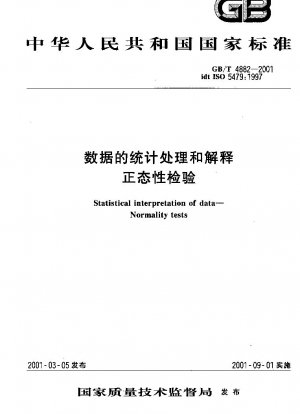GB/T 4882-2001
Statistical interpretation of data Normality tests (English Version)
- Standard No.
- GB/T 4882-2001
- Language
- Chinese, Available in English version
- Release Date
- 2001
- Published By
- General Administration of Quality Supervision, Inspection and Quarantine of the People‘s Republic of China
- Latest
- GB/T 4882-2001
- Scope
- 1.1 This standard gives guidance on methods and tests for determining whether the assumption of a normal distribution should be rejected when the observed values are assumed to be independent of each other. 1.2 When there is doubt as to whether observations follow a normal distribution, it is useful, even necessary, to use a test for deviations from the normal distribution. An example of this is the use of the t-test to check whether the mean of a sample of random observations deviates from a given theoretical value. However, in the case of robust methods (i.e. the conclusions change only slightly when the true probability distribution of the observations is not normal), testing for deviations from the normal distribution is not very necessary. 1.3 Nor is it strictly necessary to use such a test when it comes to statistical methods based on assumptions of normality. The normal distribution of the observed values may be completely unquestionable, there may be theoretical (eg physical) reasons for this assumption, or the assumption may be accepted based on prior information. 1.4 The test of deviation from normal distribution in this standard is for non-grouped raw data, not grouped data. The test also does not apply to censored data. 1.5 The test of deviation from normal distribution in this standard can be applied to observed values, and can also be applied to their functions, such as taking logarithm, square root, etc. 1.6 When the sample size is less than 8, the test effect of deviation from the normal distribution is very poor. Therefore, this standard limits the sample size to at least 8.
GB/T 4882-2001 history
- 2001 GB/T 4882-2001 Statistical interpretation of data Normality tests
